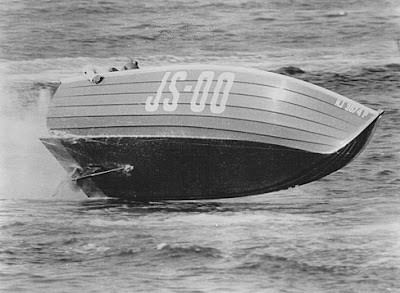Symmetry
Posted by
Unknown
at
10:30 AM
What are gains? On a lapstrake boat, like the one below, the planks overlap for the full length of the boat, but overlap magically disappears at the stem (and sometimes at the transom).

Cabin Boys macho brother
photo from the 1920s... photographer unknown
There are several ways to perform this disappearing lap trick. I chose the method that looked the simplest to me: cutting a sloping rabbet or gain along the edge of each plank.
Luckily, I had picked up an old Stanley rabbet plane at a flea market over the summer. This No. 78 plane has guides for both the width and depth of the rabbet, but because the plank was already fastened to the frame, the guides were in the way. I unscrewed them, tuned up the blade, and got to work.
By the way, Ive read several blogs where the builder laments that he doesnt have a rabbet plane, and then proceeds to make a hard job even harder by making do with the wrong tool. When I started to look for tools, I assumed it would be more or less impossible to find something as exotic as a rabbet plane. Wrong-o! Even on suburban Long Island, it is easy to find all sorts of great hand tools at garage sales, flea markets, etc. And they are cheap. So theres no reason not to have one. Or two. Or three... (Warning: buying planes is addictive.)

My hefty (and very handy) Stanley No. 78 Rabbet Plane - guides removed
photo jalmberg
Of course, I couldnt cut a straight, sloping gain without some sort of guide, so I clamped this bit of plywood along the lap line (for a 3/4" overlap).
Then it was fairly simple to cut a slopping gain, about 12" long.

Using a clamped on guide to cut the rabbet
photo jalmberg
Heres a shot that shows the basic idea... You just run the rabbet plane along the guide. To make the gain slope, you just make more passes at the end. I did it all by eye... Im not sure how to cut this slope more scientifically, but since the plywood was only 1/4" thick, we are not talking about a deep gain.
Speaking of depth, to make the lap totally disappear, you need to cut the gain so the end is paper thin. This end is backed up by the transom or stem, but I didnt have that kind of nerve. I left some thickness at the end of the gain and plan to cut a corresponding gain in the overlapping plank, so neither plank is too think on the edge.

Cutting the rabbet
photo jalmberg
Of course, you need to cut a gain on both ends of the plank. I started with the easy one at the transom. The one at the stem was twice as hard to cut, because the plank twists into the stem, and the stem gets in the way of the plane, and stops you from cutting the gain all the way to the end, even if you move the blade to the front of the plane, as the Stanley No. 78 allows.
In fact, it was such a pain to cut the gains near the stem that I totally forgot to take any pictures. Suffice to say that I cut as much as possible with the plane, and then finished the job with a chisel.
Too bad, because it would have been a classic "How-Not-To" tutorial!

Cutting the rabbet on the bench
photo jalmberg
If you are not a complete blockhead who fastens the plank to the forms before cutting the gains, you can do it the right way, as I did on the port-side garboard plank.
This is the right way to do the job... firmly clamp the plank to your bench and plane away. You can even use the width and depth guides, which Ive re-attached, above.
This gives you a nice, clean, sloping gain in about 1/8th the time.
With the gains cut, it was time to fasten the second plank to the boat. When I finished, I stepped back to take this photo:

Both garboard planks fastened
photo jalmberg
Wow! Neither this photo, nor the plans of Cabin Boy really communicate the lovely curves that make up this small fraction of a boat.
Im not really sure how John Atkin did it... The sides of the forms are straight, but every part of the boat curves in an almost magical way. Particularly the garboard planks, which not only curve but twist at both ends.
I must admit I had recently been wondering if all this work was worth it... There surely are easier boats to build, and easier methods to use.
But for the first time I had a inkling of Cabin Boys final shape, and I fell in love with the design, all over again. Yes, it is worth all the work.
>>> Next Episode: Over the Hump?
Get Notified Automatically
I hope youre enjoying "The Unlikely Boat Builder" as much as I enjoy writing it. Some people have asked for a way to be notified automatically when I post new episodes. Ive figured out how to do this, so if youd like to be notified, please click on the link below. I promise Ill never spam you (and Google will have my head if I do.)
Thanks for your interest!
-- John
Get notified automatically
Subscribe to:
Post Comments (Atom)






0 comments:
Post a Comment